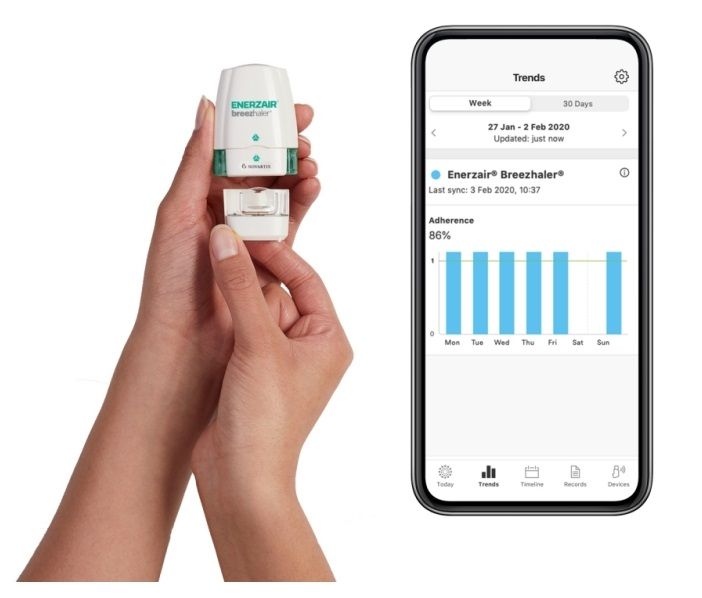

However, several studies have reported that even patients with mild or moderate COPD severity are treated with triple therapy, regardless of the risk of AECOPDs, and this not only by general practitioners, but also by specialists.

μl −1, the escalation to triple therapy is unlikely to have a major influence on AECOPDs.μl −1 in blood of patients already taking LAMA/LABA who are still having acute exacerbations of COPD (AECOPDs) identifies individuals with a greater likelihood of achieving clinical benefit when escalating to triple therapy, whereas the magnitude of effect on AECOPDs will be greater at higher eosinophil counts, particularly ≥ 300 eosinophils.In particular, the Global Initiative for Chronic Obstructive Lung Disease (GOLD) strategy states that the threshold of > 100 eosinophils The use of triple therapy containing a long-acting β-agonist (LABA), a long-acting muscarinic antagonist (LAMA) and an inhaled corticosteroid (ICS) is common in patients with chronic obstructive pulmonary disease (COPD), and this despite the restrictive recommendations of COPD guidelines or strategies. Unfortunately, the step-up approach from dual bronchodilation to triple therapy proposed by the GOLD strategy does not reflect the important differences in AECOPDs (they differ in aetiology, severity and biological substrate), and thus it is not tailored to the patient’s specific needs to be treated μl −1, but adding a LAMA to an ICS/LABA combination induces a relevant clinical benefit in the general COPD population without increasing the risk of cardiovascular SAEs.The results of meta-analyses described in this article suggest that triple combination therapy offers only a further modest clinical benefit in the general COPD population, but it is clinically relevant when a patient is on LABA/LAMA therapy and still suffers from AECOPD and has blood eosinophil counts ≥ 300 cells Recently, several meta-analyses have attempted to clarify the role of triple therapy delivered in a single inhaler in COPD

Meta-analysis can be considered as a systematic evaluation of all studies that have been conducted to answer a specific question or hypothesis Large efficacy RCTs, which are essential to show that novel treatments are effective and safe during research and development programmes, have clear limitations in relation to the transferability of their conclusions to usual care mainly because the enrolled patients are selected and not representative of the population encountered in daily practice moreover, the research environment is substantially different from that of the real worldĪlternatively, the possibility of using meta-analyses can be taken into account. The quantitative synthesis of the currently available clinical evidence seems to suggest that, in patients with COPD already on ICS/LABA combination, the therapy can be improved without an increase of cardiovascular severe adverse events (SAEs) when a LAMA is added to the combination. On the contrary, adding a LAMA to an ICS/LABA combination elicits relevant clinical benefit in the general COPD population, supporting the role of dual bronchodilation therapy for the treatment of COPD. Taking into account the results of the most recent meta-analyses, we believe that triple therapy provides modest clinical benefit in the general COPD population, but in patients on LABA/LAMA combination therapy, who still experience acute exacerbations of COPD (AECOPDs) and have blood eosinophil counts ≥ 300 cells Recently, several meta-analyses have attempted to clarify the role of triple therapy containing a long-acting β-agonist (LABA), a long-acting muscarinic antagonist (LAMA) and an inhaled corticosteroid (ICS) delivered from a single inhaler in chronic obstructive pulmonary disease (COPD), also considering that there is a big difference in the use of triple therapy between what is recommended by COPD guidelines or strategies and the prescriptive behaviour of clinicians. Because of the scarcity of data generated in large unselected populations in everyday clinical practice, the possibility of using meta-analyses can be considered. Guidelines are mainly based on evidence of well-designed randomized controlled trials (RCTs), but there are limitations to the transferability of conclusions of RCTs to usual care mainly because the patients enrolled in RCTs are selected and not representative of the population encountered in daily practice moreover, the research environment is substantially different from that of the real world.


 0 kommentar(er)
0 kommentar(er)
